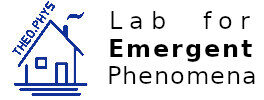Diploma thesis – Markus Spanner
Markus Spanner
Anomalous Transport in Porous Media near the Percolation Transition
finished 2010-05
supervised by Gerd Schröder-Turk, Klaus Mecke and Thomas Franosch
Abstract
A realization of the 2D Lorentz model: Obstacles (blue) are randomly placed, trajectories of a point-like ballistic tracer (orange) are simulated in the remaining void space having periodic boundaries.
Voronoi tessellation of a 2D cherry-pit system with periodic boundaries. Edges of the tessellation overlapping with spheres were removed (dotted lines). For the shown sphere radius σ there is still a path (blue) that allows infinite displacement of a tracer, but one of the channels along this path is already quite narrow (green) and percolation will break down as soon as this channel is closed by further increasing σ.
Transport properties of non-interacting fluid particles in porous materials are studied via molecular dynamics simulation in three-dimensional space. The focus is on systems where the transport is characterized by sub-diffusive behavior, that is the mean square displacement follows a power-law in time with exponent smaller than unity. We show that the mean square displacement of ballistic tracer particles (representing the non-interacting fluid particles) confined to the void space of quenched equilibrium hard sphere configurations follows δr2(t)~t2/z with z=6.25 when the obstacle radius is increased so that the void space is near its percolation transition. This exponent is the same as the exponent observed for the Lorentz model, an even simpler model for transport in porous materials, where a point-like tracer moves through an array of uncorrelated quenched spherical obstacles, which was studied previously in great detail. This shows that the exponent z is not immediately affected by structural correlations of the porous medium, at least for these two stochastic models.
Log-log plot of mean square displacement in cherry pit systems of different system sizes Lbox with hard cores packing fraction η=0.25 and obstacle radius . Hatched areas indicate the range of MSD values for obstacle sizes σ=±δσc. Lines for Lbox=150, 100 and 50 were multiplied by 10, 10² and 10³ respectively. Anomalous diffusion is compatible with t2/z, z=6.25 for all system sizes, larger systems stay longer in the sub-diffusive domain.
Furthermore we have performed simulations of particles confined to the `infinite‘ cluster, i.e. the fraction of void space that percolates through the system of obstacles. The computational challenge is to identify the percolating cluster by a suitable Voronoi tessellation before the trajectories are calculated by molecular dynamics simulations. We find that anomalous transport at the percolation threshold is still observed to obeying sub-diffusion, but with a different exponent dw=4.81 known as the walk dimension of the system in the context of random walks in lattice percolation. Again our result is independent of the obstacle correlations which is shown by simulations for hard sphere systems for a wide range of densities and for the Lorentz-model.
A realization of the 2D Lorentz model: Obstacles (blue) are randomly placed, trajectories of a point-like ballistic tracer (orange) are simulated in the remaining void space having periodic boundaries.
Voronoi tessellation of a 2D cherry-pit system with periodic boundaries. Edges of the tessellation overlapping with spheres were removed (dotted lines). For the shown sphere radius σ there is still a path (blue) that allows infinite displacement of a tracer, but one of the channels along this path is already quite narrow (green) and percolation will break down as soon as this channel is closed by further increasing σ.
Transport properties of non-interacting fluid particles in porous materials are studied via molecular dynamics simulation in three-dimensional space. The focus is on systems where the transport is characterized by sub-diffusive behavior, that is the mean square displacement follows a power-law in time with exponent smaller than unity. We show that the mean square displacement of ballistic tracer particles (representing the non-interacting fluid particles) confined to the void space of quenched equilibrium hard sphere configurations follows δr2(t)~t2/z with z=6.25 when the obstacle radius is increased so that the void space is near its percolation transition. This exponent is the same as the exponent observed for the Lorentz model, an even simpler model for transport in porous materials, where a point-like tracer moves through an array of uncorrelated quenched spherical obstacles, which was studied previously in great detail. This shows that the exponent z is not immediately affected by structural correlations of the porous medium, at least for these two stochastic models.
Log-log plot of mean square displacement in cherry pit systems of different system sizes Lbox with hard cores packing fraction η=0.25 and obstacle radius . Hatched areas indicate the range of MSD values for obstacle sizes σ=±δσc. Lines for Lbox=150, 100 and 50 were multiplied by 10, 10² and 10³ respectively. Anomalous diffusion is compatible with t2/z, z=6.25 for all system sizes, larger systems stay longer in the sub-diffusive domain.
Furthermore we have performed simulations of particles confined to the `infinite‘ cluster, i.e. the fraction of void space that percolates through the system of obstacles. The computational challenge is to identify the percolating cluster by a suitable Voronoi tessellation before the trajectories are calculated by molecular dynamics simulations. We find that anomalous transport at the percolation threshold is still observed to obeying sub-diffusion, but with a different exponent dw=4.81 known as the walk dimension of the system in the context of random walks in lattice percolation. Again our result is independent of the obstacle correlations which is shown by simulations for hard sphere systems for a wide range of densities and for the Lorentz-model.
